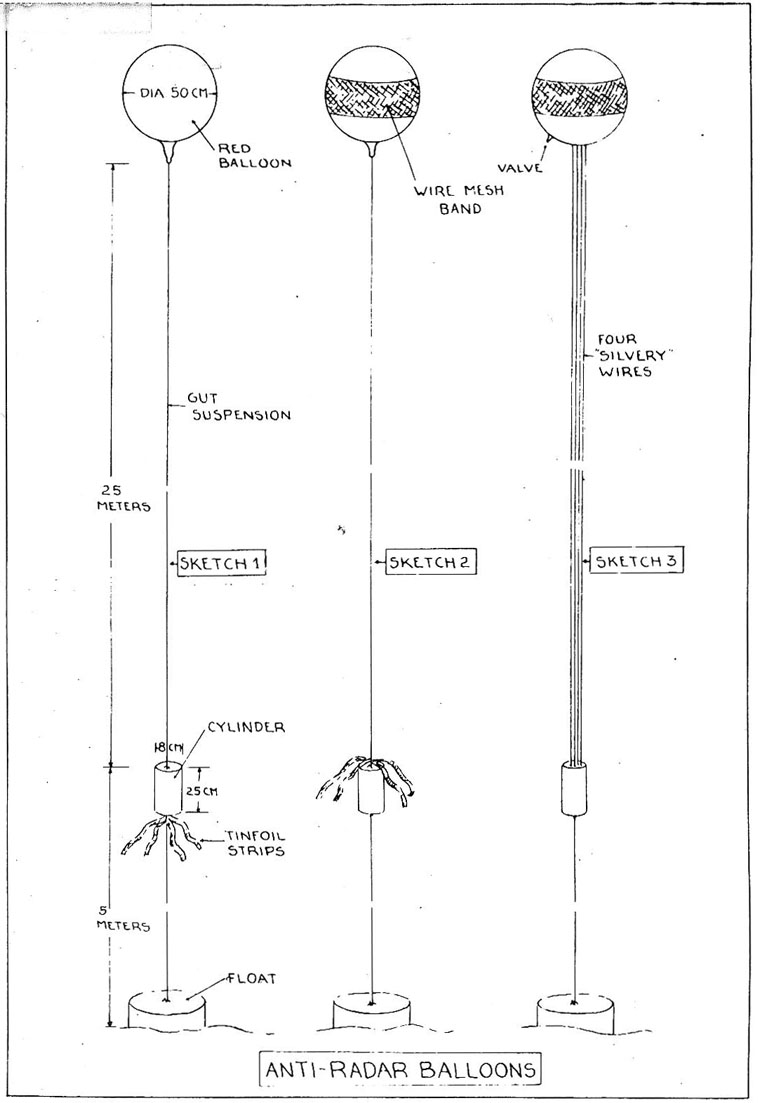| No. 126 | ||
| SECRET 26 August, 1943 | ||
| The following information has been obtained from German prisoners of war. The atatements cannot always be verified; they should, therefore, not be accepted as facts unless they are defunitely stated to be confirmed by information from other sources. | ||
| U-662 carried a supply (stated by one P/W to be 100, by the other to be 30 or 40) of anti-radar balloons. These balloons are said to have a diameter of about 50 cm. when inflated. (One P/W said they were red, the other said they were silver grey.) Both agreed they were made of gutta-percha. Around the center of the balloon runs a band of silvery wire mesh from which several wires hang down. A metal cylinder, stated to be made of tin or similar material, hangs a few feet below the balloon. The balloon is attached to a float by a light "silvery" wire (stated by one P/W to be 20 meters long and by the other to be 30 meters long). It was stated that it is the cylinder and not the balloon which is intended as a Radar target and that the purpose of the balloon is soley to hold the cylinder (said to be approximately 15 cm. tall and 8 cm. diameter) were unknown to the P/W who stated that only the officers were familiar with them. Both P/W knew that these balloons are fitted with a self-destroying device, either in the float or the balloon or both, although neither of them knew exactly how it operated or just how much time elapsed before the device sank. | ||
| It was stated that, on at least one occasion, four balloons were released simultaneously immediately before an attack on a convoy, at night. The method was stated to have been to release the balloons, submerge to periscope depth, and later resurface some distance away to attack the convoy. | ||
| Two steel cylinders containing hydrogen (about 1 m. high and about 20 cm. diameter) were mounted aft on the bridge, one on each side. The balloons were filled from these cylinders by a special attachment at the valve. | ||
| No. 131 | ||
| SECRET 31 August, 1943 | ||
| The following information has been obtained from a German prisoner of war. The atatements cannot always be verified; they should, therefore, not be accepted as facts unless they are definitely stated to be confirmed by information from other sources: | ||
| Ref. Spot Item No. 126 | ||
| Further information has been obtained about the anti-radar balloons carried by German submarines. The balloons actually carried on patrol by U-662 were of red gutta-percha. The silver-grey type was not carried. These balloons, as per attached sketch No. 1, were fitted with a small bottle shaped valve, through which the balloons were filled. This value was so fitted that once the balloon was filled, it produced a slow leak, giving off a low hissing sound. Instead of the "silvery" wire reported in Spot Item No. 126, the balloon was attached to the float by means of a catgut, similar to a violin string, and instead of the metal container being suspended a few feet below the balloon it was suspended approximately 5 meters above the water. At thte bottom of the metal container was a hook from which severl strips (prisoners believed there were 4 or more of these) of tinfoil were suspended. Another piece of catgut connected the containers with the float. Prisoners believed the float was fitted with a siluable plug so that it eventually filled with water and dragged the entire device down after a period of time, the length of which they did not know. The slow leak in the valve of the balloon also helped the sinking of the entire device. Prisoners stated that the length of catgut from the container or cylinder to the balloon was 25 meters, and confirmed that the diameter of the balloon was approximately 50 cm. | ||
| Prisoners had seen balloons with a band of wire mesh around them, used experimentally, in port, at St. Nazaire. The use of these wire mesh band was, however, discontinued because they had to be placed on the balloon after it was inflated and fell off very quickly. Two different experimental types have been seen, as illustrated in sketch No. 2 and sketch No. 2, the strips of timfoil were above the cylinder, instead of below. The cylinder used was the same on all types. On patrol the balloons were inflated by the deck watch, but the cylinder and float were attached by the engineer officer personally. The cylinder was said to be about 25 cm. high and 8 cm. diameter. The float was somewhat larger. | ||
| U-615 also carried 50 of the new type balloons when she was sunk off Trinidad. | ||

| NOTE: FURTHER INFORMATION AND/OR QUESTIONS CONCERNING THE ABOVE ARE URGENTLY REQUIRED FOR THE PURPOSE OF FURTHER INTERROGATION ON THIS SUBJECT. ALL INTERESTED BRANCHES PLEASE COMMUNICATE IMMEDIATELY WITH OP-16-Z, ROOM 3644, EXTENTION 3066. | ||
- 2 - |
||